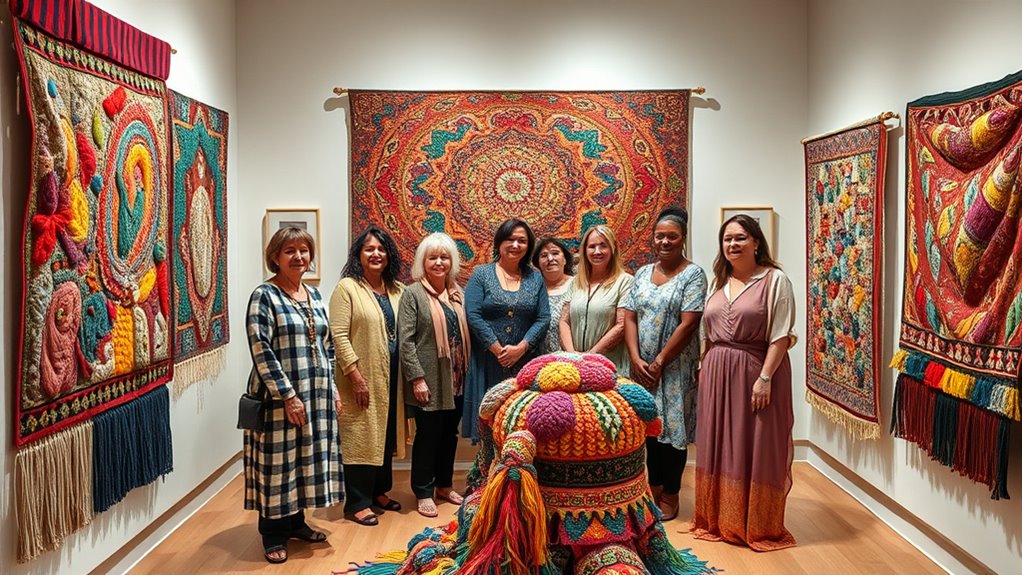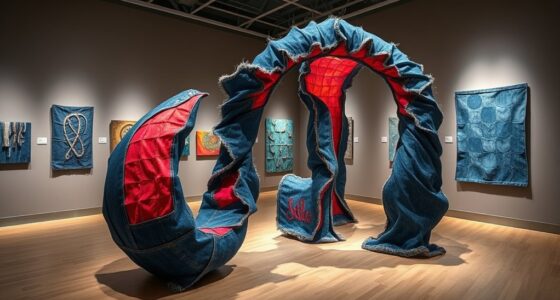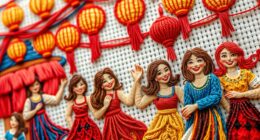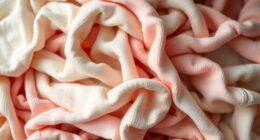To get to know some of the most influential textile artists, start with Faith Ringgold, known for storytelling through quilts, and Lenore Tawney, whose abstract textiles blend fine art and spirituality. Faith Wilding explores social issues with feminist textiles. These artists push boundaries by blending traditional techniques with unconventional materials and powerful messages. Keep exploring their stories, and you’ll discover how personal history and innovation shape their inspiring work and impact the art world.
Key Takeaways
- Highlight influential artists like Faith Ringgold and Lenore Tawney who have shaped textile art’s evolution.
- Showcase artists known for blending traditional techniques with contemporary themes and innovative materials.
- Emphasize biographical backgrounds that reveal cultural, social, or activist influences shaping their work.
- Include artists recognized for storytelling, abstraction, or political engagement through textile mediums.
- Provide insights into each artist’s unique style and contributions to elevate appreciation of textile art.

Have you ever wondered who the trailblazers behind innovative textile art are? These artists push boundaries, blending traditional techniques with contemporary ideas to create compelling works that challenge perceptions of fabric and craft. To truly appreciate their contributions, you should explore their diverse textile techniques and explore into their biographies. Each artist’s background and approach reveal the passion and innovation fueling their work, making their stories inspiring and insightful.
Many renowned textile artists have a unique way of transforming simple materials into powerful visual statements. For example, some utilize traditional techniques like quilting, embroidery, or weaving, but they elevate these methods by experimenting with scale, color, and texture. Others incorporate unconventional materials—plastic, metal, or recycled objects—to craft textiles that speak to modern issues. By studying their textile techniques, you gain insight into how they manipulate fabric and fibers to evoke emotion or provoke thought. These techniques often serve as the foundation of their artistic identity, and understanding them helps you appreciate the skill and innovation involved.
Renowned textile artists transform simple materials into evocative, innovative works through traditional and unconventional techniques.
Exploring artist biographies is equally important. Learning about their backgrounds provides context for their work, revealing how personal experiences, cultural heritage, or social activism influence their creations. For instance, some artists come from rural communities where traditional crafts are part of daily life, and their work pays homage to those roots. Others might have formal training in fine art or design, blending academic knowledge with experimental practice. Their biographies often highlight pivotal moments or influences that shaped their artistic vision, making their work more relatable and meaningful.
Famous textile artists like Faith Ringgold, Lenore Tawney, and Faith Wilding have distinct styles rooted in their life stories. Ringgold’s storytelling through fabric and quilting reflects her African-American heritage and activism. Tawney’s abstract, sculptural textiles showcase her background in fine art and her fascination with spirituality. Wilding’s feminist and political texts explore social issues through textile manipulation. By learning their biographies, you understand how their personal journeys and social contexts seep into their work, making their art resonate on a deeper level.
In essence, exploring the textile techniques and artist biographies of these pioneers enriches your appreciation of their craft. It’s not just about the finished piece but about understanding the passion, innovation, and history behind it. These artists challenge you to see fabric as a dynamic medium capable of conveying complex ideas and emotions, transforming textiles from simple crafts into powerful art forms. Whether you’re a seasoned collector or a curious newcomer, knowing their stories and techniques enhances your connection to their work and the vibrant world of textile art.
Frequently Asked Questions
What Materials Do Textile Artists Commonly Use?
You’ll find textile artists commonly use materials like cotton, wool, silk, and linen for fiber manipulation. They often incorporate various dye techniques, such as resist dyeing or shibori, to add color and texture. Some artists experiment with unconventional materials like recycled fabrics or synthetic fibers. By combining these materials with skillful dye techniques, you can create dynamic, textured pieces that showcase your creativity and mastery of textile art.
How Do Textile Artists Incorporate Technology Into Their Work?
Did you know that 65% of textile artists now incorporate technology into their work? You can explore digital weaving, where you use computers to design intricate patterns that are then woven into fabric. Augmented reality also lets you create interactive exhibits, blending physical textiles with digital overlays. By embracing these innovations, you enhance creativity, making your textile art more dynamic and engaging for viewers.
What Are Emerging Trends in Contemporary Textile Art?
You’ll notice emerging trends in contemporary textile art, like innovative fiber installation techniques that create immersive experiences. Artists are also experimenting with advanced dye techniques, blending traditional methods with modern technology for vibrant, textured effects. These trends push boundaries, encouraging you to explore new materials and processes in your work. Embrace these developments to craft dynamic, engaging pieces that challenge conventional perceptions of textile art.
How Can Beginners Start Creating Textile Art?
To start creating textile art, you should explore basic fiber techniques like weaving, embroidery, or felting. Gather inspiration by experimenting with different color palettes to find what resonates with you. Keep your projects simple at first, and don’t be afraid to try new materials and textures. Practice regularly, and gradually challenge yourself with more complex designs. Most importantly, enjoy the process and let your creativity guide you.
Are There Specific Cultural Influences in Textile Art Styles?
Yes, cultural influences shape textile art styles markedly. For example, if you explore Japanese sashiko, you’ll notice regional techniques like intricate stitching patterns and cultural motifs reflecting tradition. These influences inspire you to incorporate specific motifs and techniques from different regions into your work. By studying regional techniques and cultural motifs, you can create unique textile pieces that honor diverse traditions and tell compelling stories through your art.
Conclusion
So, now that you’re practically a textile art expert, go ahead and impress your friends with your newfound knowledge. Just don’t expect them to start weaving masterpieces overnight—some of us prefer watching paint dry, after all. Remember, these artists turned fabric into fame, so maybe your next big idea should involve a needle and thread too. Who knew textiles could be so glamorous? Now, go forth and stitch your way into stardom!










